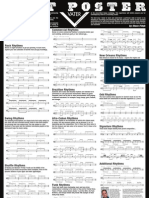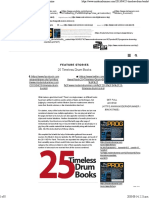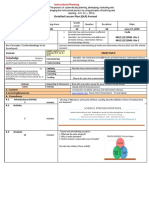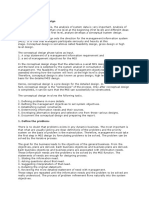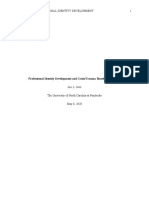(Drums Book) Steve Smith - Art of Practice
(Drums Book) Steve Smith - Art of Practice
Uploaded by
Boris DentiCopyright:
Available Formats
(Drums Book) Steve Smith - Art of Practice
(Drums Book) Steve Smith - Art of Practice
Uploaded by
Boris DentiOriginal Title
Copyright
Available Formats
Share this document
Did you find this document useful?
Is this content inappropriate?
Copyright:
Available Formats
(Drums Book) Steve Smith - Art of Practice
(Drums Book) Steve Smith - Art of Practice
Uploaded by
Boris DentiCopyright:
Available Formats
Summary of the main points in
The Art of Practice
Developing good practice skills can be an art form in itself. What we practice and how we practice are
very important to ones development as a musician.
WHAT DO YOU PRACTICE?
This will be different for everyone depending on your stage of musical development and what you need
in order to move forward. Here are some ideas and recommendations:
1 - Practice whatever you need to do a better job on the gigs you are currently playing. You will have
some relevant ideas to work on by remembering what songs or feels you had trouble with, listening
to a recording of the gig or by using feedback from the other band members.
2 - I recommend studying with a good private teacher to learn how to read music, develop good tech-
nique, be exposed to interesting ideas and approaches, and to get clear and instant feedback on your
progress. By studying with a teacher you can also develop good practice discipline because you’ll
need to prepare a weekly lesson.
3 - Use your practice time to work on and develop your own ideas.
4 - Use your practice time to learn music and prepare for an upcoming gig, session or audition.
5 - Work on an idea that interests you that you read about in a magazine or that you hear someone play
on a CD, a live gig/clinic or an educational DVD/video.
HOW DO YOU PRACTICE?
Here are some practicing principles I use that have helped me continue to grow as a player.
1 - Practice Every Day with an occasional day off.
2 - Be Organized and Consistent - know what you are going to practice each day and stick to the plan.
3 - Use Patience and Take Your Time.
4 - Practice Quietly and Slowly. By doing this you gain control at many Volumes and Tempos.
5 - Figure out the Stickings and Hand/Foot combinations. With this process you gain an under-
standing of the information in the idea. With Consistent, Slow and Relaxed practice you allow the
information to enter your subconscious.
6 - Slowly work out the motions necessary to play the ideas and eventually allow the motions start to
“play themselves.”
7 - Breath slowly, relax and use the practice as a meditation. Develop the habit of playing relaxed,
don’t hold tension in your body. Use a mirror to watch your motions.
8 - Eventually “hear” the idea in your head and allow your body to respond and play it effortlessly.
9 - Practice with Musical Form, (e.g. 4 & 8 bar phrases, 12 bar blues, 32 bar AABA song form) play
along with CDs, and practice both with and without a click track.
10 - Warm up before the practice session, stop when fatigued.
You might also like
- English Pronunciation in Use Advanced Book With Answers and Audio Cds Frontmatter PDFDocument7 pagesEnglish Pronunciation in Use Advanced Book With Answers and Audio Cds Frontmatter PDFd-fbuser-18038696933% (21)
- Vdocument - in Marco Minnemann Extreme InterdependenceDocument108 pagesVdocument - in Marco Minnemann Extreme InterdependencetopNo ratings yet
- 507 Hybrid Rudiments Ninja DrummistDocument7 pages507 Hybrid Rudiments Ninja DrummistDario RomanNo ratings yet
- Vater BeatPosterDocument1 pageVater BeatPostergabrix68100% (1)
- Broken 8th FeelDocument6 pagesBroken 8th FeelClint Hopkins100% (3)
- Jojo Mayer - Performance 1 Complete PDFDocument4 pagesJojo Mayer - Performance 1 Complete PDFAmadeo Testi100% (1)
- Chops Mastery 1Document36 pagesChops Mastery 1陳易No ratings yet
- Anika Part 1 Lesson NotesDocument4 pagesAnika Part 1 Lesson NotesDiego Daniel100% (1)
- 25 Timeless Drum Books PDFDocument8 pages25 Timeless Drum Books PDFBill E MoonNo ratings yet
- Thomas Lang - Creative Coordenation e Advanced Foot TechniqueDocument4 pagesThomas Lang - Creative Coordenation e Advanced Foot Techniquerodrigocavica100% (1)
- Alan Dawson - Rudimental RitualDocument12 pagesAlan Dawson - Rudimental RitualMiklós KovácsNo ratings yet
- Master Studies II More Exercises For The Development of Control and TechniqueDocument3 pagesMaster Studies II More Exercises For The Development of Control and TechniqueSalvatore Martone0% (1)
- p7 p8 m3 - Personal - DevelopmentDocument2 pagesp7 p8 m3 - Personal - DevelopmentSulakShana SumaruthNo ratings yet
- Detailed Lesson Plan (DLP) Format: Mil11/121Mil-Iiia-1 Mil11/121Mil-Iiia-2Document2 pagesDetailed Lesson Plan (DLP) Format: Mil11/121Mil-Iiia-1 Mil11/121Mil-Iiia-2Elsie Alcover Relacion100% (1)
- Linear DrummingDocument5 pagesLinear DrummingAmadeo Testi100% (1)
- Chops Builders Exercise 1Document1 pageChops Builders Exercise 1pindonga gomezNo ratings yet
- 12 Rudimentos 12 Hand MotionsDocument4 pages12 Rudimentos 12 Hand MotionsÉrica SáNo ratings yet
- Bass and Snare Drum ExercisesDocument5 pagesBass and Snare Drum ExercisesHarrison100% (1)
- Experiemtn PorcaroDocument207 pagesExperiemtn PorcaromonoNo ratings yet
- Books, Playalongs, Video SchoolsDocument49 pagesBooks, Playalongs, Video SchoolsHwee Tawan ChiraseepanyaNo ratings yet
- Moeller Drum ExerciseDocument1 pageMoeller Drum ExerciseSacrafames13100% (1)
- Stick Technique Revisited II - Modern Drummer MagazineDocument4 pagesStick Technique Revisited II - Modern Drummer MagazineAlex MagniNo ratings yet
- In The POCKET Feb 2010 Jim Payne's Funk GroovesDocument2 pagesIn The POCKET Feb 2010 Jim Payne's Funk Groovesprivatexxx50% (2)
- Mean Streets - Kenny WashingtonDocument3 pagesMean Streets - Kenny WashingtonmNo ratings yet
- The 'Show Stopper' Sextuplet ChopDocument7 pagesThe 'Show Stopper' Sextuplet ChopMichael JohnsonNo ratings yet
- 24 Intermediate - Drum Fills - Lesson #2 (2) - 2 PDFDocument2 pages24 Intermediate - Drum Fills - Lesson #2 (2) - 2 PDFDul Gar100% (1)
- Partial GriddingDocument105 pagesPartial GriddingAlberto CabezaNo ratings yet
- Jim Chapin BookDocument54 pagesJim Chapin BookJuanNo ratings yet
- The Single Paradiddle Displacement ChallengeDocument1 pageThe Single Paradiddle Displacement ChallengeFábio de AlbuquerqueNo ratings yet
- PDF Drum Book - Drum-LessonDocument3 pagesPDF Drum Book - Drum-LessonFelix Tvedegaard Heim100% (1)
- Joe Morello Rudimental JazzDocument49 pagesJoe Morello Rudimental JazzAndré Cunha100% (1)
- Brian Tichy - Effective Triplets For Rock DrummingDocument3 pagesBrian Tichy - Effective Triplets For Rock DrummingEduardo SantosNo ratings yet
- Fernando Martinez - Funk GroovesDocument93 pagesFernando Martinez - Funk GroovesEduardo Rosa100% (1)
- The Third Hand PDFDocument2 pagesThe Third Hand PDFBreno Firme PereiraNo ratings yet
- Jazz Drum Patterns 432: Listen To Each Beat or Download Midi File Online 1Document3 pagesJazz Drum Patterns 432: Listen To Each Beat or Download Midi File Online 1Rudy LievensNo ratings yet
- 2013 Drum Notes For BeginnersDocument8 pages2013 Drum Notes For BeginnerstwkroosterNo ratings yet
- Interactive Pearl Rudiment Poster 2017Document1 pageInteractive Pearl Rudiment Poster 2017Letterio NaccariNo ratings yet
- Anika Nilles - Alter EgoDocument5 pagesAnika Nilles - Alter EgoHenrique100% (1)
- Berklee 1 and 2 Stroke RollsDocument5 pagesBerklee 1 and 2 Stroke RollsBen Singer100% (2)
- Practicing Rudiments With Metric ModulationDocument2 pagesPracticing Rudiments With Metric ModulationGiovanni Ziparo100% (4)
- Steve Fidyk History Drum SetDocument9 pagesSteve Fidyk History Drum SetvladmoonshadeNo ratings yet
- Percmanualgrp 1Document58 pagesPercmanualgrp 1Sir FlamalotNo ratings yet
- Developing Snare Drum Rolls - PN8307.49-52Document4 pagesDeveloping Snare Drum Rolls - PN8307.49-52Cristiano Pirola100% (2)
- Tim's Favorite Exercises (Free Ebook)Document7 pagesTim's Favorite Exercises (Free Ebook)Maria Carvalho100% (2)
- Linear Drummig PDFDocument83 pagesLinear Drummig PDFLucio Llon100% (1)
- Berklee Exercises The Reading Drummer PDFDocument14 pagesBerklee Exercises The Reading Drummer PDFJon PreeceNo ratings yet
- Technique Packet-Snare Drum 2012Document9 pagesTechnique Packet-Snare Drum 2012api-186882135No ratings yet
- Essence of Jazz Total ProgramDocument12 pagesEssence of Jazz Total ProgramMatt D FNo ratings yet
- Single Stroke Roll TechniqueDocument2 pagesSingle Stroke Roll TechniqueClint Hopkins100% (1)
- Thomas Lang - Creative Coordination & Advanced Foot TechniqueDocument179 pagesThomas Lang - Creative Coordination & Advanced Foot TechniqueLucas Wilson100% (1)
- New Breed II Gary ChesterDocument88 pagesNew Breed II Gary ChesterTUGUI LIVIU100% (1)
- John Ramsay The Drummers Complete Vocabulary As Taught by Alan DawsonpdfDocument77 pagesJohn Ramsay The Drummers Complete Vocabulary As Taught by Alan DawsonpdfanshuNo ratings yet
- Shuffle ThesaurusDocument2 pagesShuffle ThesaurusGonzalo Sepúlveda100% (6)
- Buddy Rich - Snare Drum RudimentsDocument101 pagesBuddy Rich - Snare Drum RudimentsMateus Mioto100% (1)
- Wake 'N Break Volume 1: 30 Drum Grooves To Start Your DayFrom EverandWake 'N Break Volume 1: 30 Drum Grooves To Start Your DayRating: 4.5 out of 5 stars4.5/5 (3)
- Drums For DummiesDocument4 pagesDrums For DummiesBoris DentiNo ratings yet
- I Beat Del Reggae: One Drop Steppers RockersDocument4 pagesI Beat Del Reggae: One Drop Steppers RockersBoris DentiNo ratings yet
- I Beat Del Reggae: One Drop Steppers RockersDocument4 pagesI Beat Del Reggae: One Drop Steppers RockersBoris DentiNo ratings yet
- A Riddle of RudimentsDocument2 pagesA Riddle of RudimentsBoris DentiNo ratings yet
- G11-CSS June 22 (Am)Document2 pagesG11-CSS June 22 (Am)Rodel MoralesNo ratings yet
- Grade 12 Stem Media & Information LiteracyDocument52 pagesGrade 12 Stem Media & Information LiteracyJun Joseph Juare100% (1)
- Conceptual DesignDocument8 pagesConceptual DesignPallavi SacharNo ratings yet
- LX CanvasDocument2 pagesLX Canvasapi-514920611No ratings yet
- level 2second semester COMPLETEDocument33 pageslevel 2second semester COMPLETEzkfy8xmpqzNo ratings yet
- Unit 6: Doing That Sounds Like FunDocument7 pagesUnit 6: Doing That Sounds Like Funnursilvia zannahNo ratings yet
- Esol ReflectionDocument3 pagesEsol Reflectionapi-327783382No ratings yet
- Nursing Management Planning and OgranizationDocument2 pagesNursing Management Planning and OgranizationAndee SalegonNo ratings yet
- Cabay NHS ME PlanDocument19 pagesCabay NHS ME PlanAnna Marie Andal RanilloNo ratings yet
- Critical Approach To Journalism StudiesDocument20 pagesCritical Approach To Journalism StudiesJorge100% (4)
- Educational Management - SWOT AnalysisDocument16 pagesEducational Management - SWOT AnalysisImus City-Michael ZunigaNo ratings yet
- Covered Student Outcome Fundamental and Engineering Knowledge (A) Development of Engineering Solution (B)Document1 pageCovered Student Outcome Fundamental and Engineering Knowledge (A) Development of Engineering Solution (B)ZainalAbidinNo ratings yet
- Swadhin Kumar Das's Action Plan: CoachingDocument2 pagesSwadhin Kumar Das's Action Plan: CoachingSwadhin Kumar DasNo ratings yet
- The - Three - Common - Tenses - Used - in - Academic - WritingATI PDFDocument3 pagesThe - Three - Common - Tenses - Used - in - Academic - WritingATI PDFAndres Felipe Suarez SuarezNo ratings yet
- Complete I - Teaching Guides For NTA Level 6 MLS Curriculum - 12 May 2012 (Repaired)Document356 pagesComplete I - Teaching Guides For NTA Level 6 MLS Curriculum - 12 May 2012 (Repaired)david mchembeNo ratings yet
- Jeter LitreviewDocument9 pagesJeter Litreviewapi-565900338No ratings yet
- Week 15 MathDocument10 pagesWeek 15 MathSabin TahirNo ratings yet
- Physics and Philosophy: Werner Carl HeisenbergDocument32 pagesPhysics and Philosophy: Werner Carl HeisenbergMirceaNo ratings yet
- School PortfolioDocument1 pageSchool Portfolioapi-338220567No ratings yet
- Research Proposal: Student Facing Gender Discrimination by NSU FacultiesDocument5 pagesResearch Proposal: Student Facing Gender Discrimination by NSU FacultiesImtiaz AhamedNo ratings yet
- Relational Understanding and Instrumental Understanding: Faux AmisDocument8 pagesRelational Understanding and Instrumental Understanding: Faux AmisVanessa KasiNo ratings yet
- 4.the Scientific AttitudeDocument7 pages4.the Scientific Attitudelaode ihksan juarzanNo ratings yet
- Theory and Practice of Coun-Seling and Psychotherapy: Gerald CoreyDocument32 pagesTheory and Practice of Coun-Seling and Psychotherapy: Gerald CoreyAttapon WaipripNo ratings yet
- Understanding of Addition of Whole Numbers Up To 1000 Including MoneyDocument7 pagesUnderstanding of Addition of Whole Numbers Up To 1000 Including MoneyJennifer Modina SupranesNo ratings yet
- 10-1108 - 09578239510098536 Professional Development For Schoolheads The Role of MentoringDocument14 pages10-1108 - 09578239510098536 Professional Development For Schoolheads The Role of MentoringKiew Soon LeeNo ratings yet
- Hum 101 Instructor Course GuideDocument3 pagesHum 101 Instructor Course GuideLeire JacutanNo ratings yet
- North Central Mindanao College: BM7: Organizational ManagementDocument6 pagesNorth Central Mindanao College: BM7: Organizational ManagementAndriea MathitNo ratings yet



